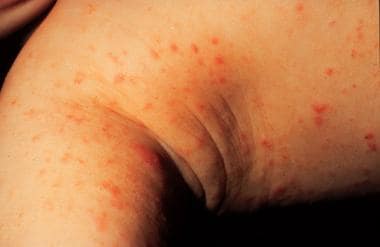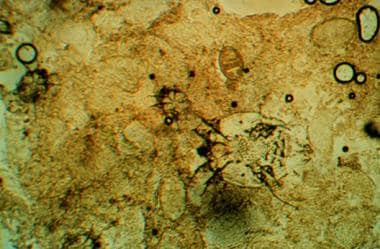Background
Human scabies is an intensely pruritic skin infestation (see the image below) caused by the mite Sarcoptes scabiei var hominis. [1] This mite is a host-specific obligate parasite that completes its entire life cycle on humans. Other varieties of S scabiei cause infestation in other mammals, such as dogs, cats, pigs, ferrets, and horses. These varieties can irritate human skin as well but are unable to reproduce in humans and cause only a transient dermatitis.
Although scabies is a readily treatable infestation, it remains common, primarily because of diagnostic difficulty, inadequate treatment of patients and their contacts, and improper environmental control measures. Scabies is a great clinical imitator, and its spectrum of cutaneous manifestations and associated symptoms often results in delayed diagnosis. In fact, the term seven-year itch was first used with reference to persistent, undiagnosed infestations with scabies.
Scabies is a global public health problem, affecting persons of all ages, races, and socioeconomic groups. [2] Overcrowding, delayed diagnosis and treatment, and poor public education contribute to the prevalence of scabies in industrialized and developing nations.
The prevalence of scabies is greater in children and sexually active individuals than in other persons. Patients with poor sensory perception due to entities such as leprosy and persons with immunocompromise due to conditions such as status posttransplantation, HIV disease, and old age [3] are at particular risk for the crusted (or Norwegian) variant. These populations present with clinically atypical lesions and often are misdiagnosed, thus delaying treatment and elevating the risk of local epidemics.
Burrows are a pathognomonic sign and represent the intraepidermal tunnel created by the moving female mite. Classic scabies typically has a distribution involving the axillae, elbow flexures, wrists and hands, and genital area. In geriatric patients, scabies demonstrates a propensity for the back, often appearing as excoriations. In infants and small children, burrows are commonly located on the palms and soles. One- to 3-mm erythematous papules and vesicles are seen in typical distributions in adults.
Nodules occur in 7-10% of patients with scabies, particularly young children. In crusted scabies, lesions are often hyperkeratotic and crusted and cover large areas. The hands and arms are the usual locations for lesions, but all sites are vulnerable. Secondary lesions may result from scratching, secondary infection, or the host’s immune response to the scabies mites and their products.
The diagnosis of scabies can often be made clinically and is confirmed by means of light microscopy. [4] In rare cases, mites are identified in biopsy specimens obtained to rule out other dermatoses. Clinically inapparent infection can be detected by amplification of Sarcoptes DNA in epidermal scale. In addition, elevated immunoglobulin E (IgE) titers and eosinophilia may be demonstrated in some patients.
Treatment includes administration of a scabicidal agent (eg, permethrin or ivermectin), as well as an appropriate antimicrobial agent if a secondary infection has developed. Pruritus may be partially alleviated with an oral antihistamine; in rare cases, prednisone may be given to treat severe pruritus. Patients with crusted scabies may require repeated applications of topical scabicides or treatment with a combination of oral ivermectin and a topical agent.
Pathophysiology
Mode of transmission
Transmission of scabies predominantly occurs via direct skin-to-skin contact, and for this reason, scabies has been considered a sexually transmitted disease. The S scabiei var hominis mite does not penetrate deeper than the superficial layer of the epidermis, the stratum corneum. People infested with mites can spread scabies even if they are asymptomatic. [1] There may be a prolonged interval (up to 10 wk) between the primary infection, when the patient becomes contagious, and the onset of clinical manifestations. [5, 6]
It is less common for scabies to be transmitted through indirect contact involving fomites such as infested bedding or clothing. However, the greater the number of parasites on a person, as in crusted scabies, the more likely it is that indirect contact will transmit the disease.
The scabies mite that infests humans is female and is large enough (0.3-0.4 mm long) to be seen with the naked eye. (The male is about half this size.) It has four pairs of legs and crawls at a rate of 2.5 cm/min; it is unable to fly or jump. [7] (See the image below.) Although the mite's life cycle occurs completely on the host, it is able to live on bedding, clothes, or other surfaces at room temperature for 2-3 days while remaining capable of infestation and burrowing. At temperatures below 20°C, S scabiei mites are immobile, although they can survive such temperatures for extended periods.
Mite life cycle
Over a 30- to 60-day lifespan, the female S scabiei var hominis mite lays 60-90 eggs, of which fewer than 10% result in mature mites. The average patient is infected with 10-15 live adult female mites at any given time. Life cycle stages are as follows:
-
Eggs incubate and hatch in 3-4 days (90% of the hatched mites die)
-
Larvae (with three pairs of legs) migrate to the skin surface and burrow into the intact stratum corneum to make short burrows, called molting pouches (3-4 days)
-
Larvae molt into nymphs (with four pairs of legs), which molt once into larger nymphs before becoming adults
-
Mating takes place once, and the female is fertile for the rest of her life; the male dies soon after mating
-
The female makes a serpentine burrow using proteolytic enzymes to dissolve the stratum corneum of the epidermis, laying eggs in the process; she continues to lengthen her burrow and lay eggs for the rest of her life, surviving for 1-2 months
-
Transmission of impregnated females from person to person occurs through direct or indirect skin contact
Classic scabies
In classic scabies, typically 10-15 mites (range, 3-50) live on the host. [7] Little evidence of infection exists during the first month (range, 2-6 wk), but after 4 weeks and with subsequent infections, a delayed type IV hypersensitivity reaction to the mites, eggs, and scybala (feces) occurs. The time required to induce immunity in primary infestations probably accounts for the 4-week asymptomatic latent period. With reinfestation, the sensitized individual may develop a rapid reaction (within hours). The resultant skin eruption and its associated intense pruritus are the hallmarks of classic scabies. (See Presentation.)
An immunologic study analyzing the cellular infiltrate types and patterns in scabies lesions concluded that T4-cell dominance is the cause of persistent itching, whereas an increase in T8 cells reduces pruritus. [8]
Crusted scabies
Crusted, or Norwegian, scabies (so named because the first description was from Norway in the mid-1800s) is a distinctive and highly contagious form of the disease. In this variant, hundreds to millions of mites infest the host individual, who is usually immunocompromised, elderly, or physically or mentally disabled and impaired. [9, 10] (Assessment of immune function may be indicated in individuals presenting with crusted scabies.)Some data have suggested a higher incidence of autoimmune diseases in patients with scabies. [11]
Crusted scabies can be easily confused with severe dermatitis or psoriasis because widespread, crusted lesions appear with thick, hyperkeratotic scales over the elbows, knees, palms, and soles. (See Presentation.) The diagnosis of crusted scabies should be considered when suspected dermatitis or suspected psoriasis does not respond to usual treatments. [12]
Although serum immunoglobulin E (IgE) and IgG levels are extremely high in patients with crusted scabies, the immune reaction does not seem to be protective. Whereas cell-mediated immunity in classic scabies has demonstrated T4-cell predominance in the dermal infiltrate, some evidence has suggested a T8-cell predominance in crusted scabies.
Certain patient populations are particularly susceptible to crusted scabies, including patients with primary immunodeficiency disorders or a compromised ability to mount an immune response secondary to drug therapy. A modified host response may be a key factor in patients with malnutrition. Motor nerve impairments result in the inability to scratch in response to the pruritus, thus disabling the utility of scratching for removal of mites and destruction of burrows. Rare cases have been described in which immunocompetent patients have developed the crusted variant without clear explanation.
Etiology
S scabiei var hominis, the host-specific obligate parasite that causes human scabies, is a member of the family Sarcoptidae, which belongs to the order Astigmata, in the subclass Acari, class Arachnida.
Human infestation with S scabiei varieties of animal origin can also occur. Domestic and wild animals worldwide are susceptible to infestation with S scabiei, and the resultant disease is referred to as sarcoptic mange. Mange due to S scabiei varieties other than hominis has been reported in dogs, pigs, horses, camels, black bears, monkeys, dingoes, and wild foxes, among other animals.
Although reports have described transfer to humans from animals, experimental studies have demonstrated only limited cross-infectivity between different host species. Furthermore, genotyping studies have revealed that the Sarcoptes mites segregate into separate host-associated populations, therby limiting transmission across host species.
In the rare instances of transmission of nonhuman scabies from animals to humans, the clinical manifestations differ from the usual ones in many respects: The incubation period is shorter, the symptoms are transient, the infestation is self-limiting, no burrows are formed, and the distribution is atypical in comparison with infestation caused by S scabiei hominis. Contacts of patients with scabies contracted from an animal source require no treatment.
Risk factors
The prevalence of scabies is higher in children and sexually active individuals than in other persons. Older adults are a vulnerable population as well. [3] Patients with poor sensory perception due to entities such as leprosy and persons with immunocompromise due to conditions such as status post transplant, HIV disease, and old age are at particular risk for the crusted variant.
A 2009 study conducted in an impoverished rural community in Brazil identified the following major risk factors for scabies in that community [13] :
-
Young age
-
Presence of many children in the household
-
Illiteracy
-
Low family income
-
Poor housing
-
Sharing of clothes and towels
-
Irregular use of showers
Epidemiology
US and international statistics
Scabies occurs worldwide, but the incidence and prevalence are highest in hot, tropical countries and in areas of high population density. Globally, an estimated 200 million people are affected by scabies at any given time. [1] Natural disasters, war, and poverty lead to overcrowding and increased rates of transmission. [14, 15]
In industrialized countries, scabies epidemics occur primarily in institutional settings (eg, prisons) and in long-term care facilities (eg, hospitals and nursing homes). [16, 17, 18] Scabies occurs more commonly in fall and winter months in these countries. The prevalence rates is generally higher in developing nations than in industrialized countries.
Among 200 dermatology outpatients with scabies in Sirte, Libya, the following distribution was found [19] :
-
Females - 59%
-
Children - 37.5%
-
Military personnel - 18%
Many accounts of the epidemiology of scabies have suggested that epidemics or pandemics occur in 30-year cycles, but this may be an oversimplification, given that these accounts have coincided with the major wars of the 20th century. Because scabies is not a reportable disease and data are based on variable notification, its true incidence is difficult to ascertain.
It is clear that scabies is an endemic disease in many tropical and subtropical regions, being one of six major epidermal parasitic skin diseases (EPSDs) that are prevalent in resource-poor populations. [20] Prevalence figures are extremely high in indigenous populations in Australia, Africa, South America, [21] and other developing regions of the world. Incidence figures in parts of Central and South America approach 100%. [20] One report suggested that the highest reported rates of crusted scabies in the world are in remote Aboriginal communities of northern Australia. [22]
Age- and sex-related demographics
According to World Health Organization (WHO), the prevalence of scabies among children in resource-poor tropical countries ranges from 5% to 50%. [1]
In a 2009 retrospective study of 30,078 children in India, scabies was found to be the second most common skin disease in all age groups of children and the third most common skin disease in infants. [23]
In parts of Bangladesh, the number of children with scabies has been found to exceed the number with diarrheal and respiratory diseases combined. [20]
A survey of children in a welfare home in Pulau Pinang, Malaysia, found that the infestation rate for scabies was highest among children aged between 10 and 12 years. [24] The disease was more commonly evident in boys (50%) than in girls (16%). The overall prevalence of scabies was 31%.
Prognosis
With proper diagnosis and treatment, the prognosis for individuals with classic scabies who are otherwise healthy is excellent. If one medication is ineffective, sequential use of agents can be curative.
Immunocompromised or institutionalized individuals are at an increased risk for crusted scabies, which is associated with a less favorable outcome. Crusted scabies carries a higher mortality than the classic form of the disease because of the frequency of secondary bacterial infections resulting in sepsis. [25] Patients with crusted scabies often contribute to widespread infestation in long-term care facilities, and delays in diagnosis contribute to the spread. [26]
Persistent symptoms in scabies may remain for as long as 2-4 weeks after treatment. Anxiety or a hypersensitivity state may prolong symptoms even after the mites have been destroyed. Residual pruritus may warrant the use of antihistamines or a short course of topical or oral steroids. If symptoms last longer than 2-4 weeks, the patient should be treated with another dose of scabicides. [7, 5]
Symptoms may also persist as a result of the following:
-
Treatment failure
-
Allergic dermatitis due to the topical medicine used
-
Ordinary household mites that cause a cross reactivity, driving persistent symptoms
-
Acarophobia - Delusional parasitosis; requires psychiatric intervention
-
Secondary infection requiring antibiotics
-
Scabies mite scraped from burrow (original magnification, 400X).
-
Typical linear burrow on flexor forearm. Image from Kenneth E Greer, MD.
-
Subtle linear burrow accompanied by erythematous papules on sole of foot in child with scabies. Image from Kenneth E Greer, MD.
-
Erythematous papules and papulovesicles on flexor wrist. Image from Kenneth E Greer, MD.
-
Scabies on penile shaft and glans. Image from William D James, MD.
-
Scabietic papules on penile shaft and scrotum. Image from Kenneth E Greer, MD.
-
Widespread eruption on back of infant with scabies. Image from Kenneth E Greer, MD.
-
Nodular scabies in infant. Image from Kenneth E Greer, MD.
-
Nodular scabies. Image from Kenneth E Greer, MD.
-
Crusted scabies. Image from William D James, MD.
-
Crusted scabies. Image from Kenneth E Greer, MD.
-
Scabies preparation demonstrating mite and ova. Image from William D James, MD.
-
Scabies. Erythematous vesicles and papules are present on torso extremities, some with adjacent linear excoriations.
-
In routine scabies, single mite is seen. Eosinophilic spongiosis may be present (hematoxylin and eosin; original magnification, 400X).
-
Scabies mite in stratum corneum. Image from William D James, MD.
-
In crusted scabies, sections show multiple mites (arrows) within hyperkeratotic stratum corneum. Epidermis is spongiotic (hematoxylin and eosin; original magnification, 100X).
-
Scabies. Image from William D James, MD.
-
Scabies in interdigital web spaces. Image from William D James, MD.
-
Papulovesicles and nodules on palm in patient with scabies. Image from Kenneth E Greer, MD.
-
Scabies on buttocks. Image from William D James, MD.
-
Scabies on penis. Image from Hon Pak, MD.











